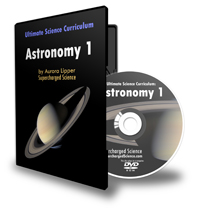Discover the big ideas behind Newtons ground-breaking work. Students will learn about magnetic storms, listen to the song of the sun, learn how to chart the stars, and build a simple handheld telescope.
Step 1. Click Here to download the Student Guidebook.
To download the Parent/Teacher Guidebook, Click Here.
Step 2. Watch the videos that go with it below.
Lesson #1: Planetarium & Star Show
Overview: Greetings and welcome to the study of astronomy! This first lesson is simply to get you excited and interested in astronomy so you can decide what it is that you want to learn about astronomy later on.
What to Learn: We’re going to cover a lot in this presentation, including: The Sun, an average star, is the central and largest body in the solar system and is composed primarily of hydrogen and helium.
The solar system includes the Earth, Moon, Sun, eight other planets and their satellites, and smaller objects such as asteroids and comets. The structure and composition of the universe can be learned from the study of stars and galaxies. Galaxies are clusters of billions of stars, and may have different shapes. The Sun is one of many stars in our own Milky Way galaxy. Stars may differ in size, temperature, and color.
Materials
- Popcorn (to eat if you’d like to)
- Pencil
[am4show have=p110; guest_error=Guest error message user_error=User error message ]
Lesson #2: Solar System Treasure Hunt
Overview: Fun day! You get to do not one, but two treasure hunts today. The first is on paper and asks questions about the presentation from last time. The second activity has 10 clues with real treasure. The more you know about astronomy, the faster you’ll move through these.
What to Learn: Today you’ll discover how much you already know about the specific details about all eight planets, the Sun and its composition, selected natural satellites, and smaller objects such as asteroids, dwarf planets, and comets.
Materials
- A pencil
- Print out the clue cards (have an adult helper hide them for you)
Lesson #3: Magnetic Tornadoes
Overview: This lab is a physical model of what happens on Mercury when two magnetic fields collide and form magnetic tornadoes.
What to Learn: You’ll get to investigate what an invisible magnetic tornado looks like when it sweeps across Mercury.
Materials
- Two clear plastic bottles (2 liter soda bottles work best)
- Steel washer with a 3/8 inch hole
- Ruler and stopwatch
- Glitter or confetti (optional)
- Duct tape (optional)
Lesson #4: Sky in a Jar
Overview: Have you ever wondered why the sky is blue? Or why the sunset is red? Or what color our sunset would be if we had a blue giant instead of a white star? This lab will answer those questions by showing how light is scattered by the atmosphere.
What to Learn: Particles in the atmosphere determine the color of the planet and the colors we see on its surface. The color of the star also affects the color of the sunset and of the planet.
Materials
- Glass jar
- Flashlight
- Fingernail polish (red, yellow, green, blue)
- Clear tape
- Water
- Dark room
- Few drops of milk
Lesson #5: Planetary Magnetic Fields
Overview: You’re going to use a compass to figure out the magnetic lines of force from a magnet by mapping the two different poles and how the lines of force connect the two. A magnetic field must come from a north pole of a magnet and go to a south pole of a magnet (or atoms that have turned to the magnetic field.)
What to Learn: Compasses are influenced by magnetic lines of force. These lines are not necessarily straight. When they bend, the compass needle moves. The Earth has a huge magnetic field. The Earth has a weak magnetic force. The magnetic field comes from the moving electrons in the currents of the Earth’s molten core. The Earth has a north and a south magnetic pole which is different from the geographic North and South Pole.
Materials
- Bar magnet
- Horseshoe magnet
- Circular (disk) magnet
- Compass
- String
- Ruler
Lesson #6: Seasons
Overview: One common misconception is that the seasons are caused by how close the Earth is to the Sun. Today you get to do an experiment that shows how seasons are affected by axis tilt, not by distance from the Sun. And you also find out which planet doesn’t have sunlight for 42 years.
What to Learn: The seasons are caused by the Earth’s axis tilt of 23.4o from the ecliptic plane.
Materials
- Bright light source (not fluorescent)
- Balloon
- Protractor
- Masking tape
- 2 liquid crystal thermometers
- Ruler, yardstick or meter stick
- Marker
Lesson #7: Indoor Rain Clouds
Overview: Today you get to vaporize liquid oceans of molecules and make it rain when the rising cloud decks hit the coldness of space. Sound like fun?
What to Learn: The movement of atmospheres on different planets is affected by the temperature of the planet and the molecules in the atmosphere.
Materials
- Glass of ice water
- Glass of hot water
- Towel
- Ruler
Lesson #8: Volcanoes
Overview: Mars has some of the biggest canyons and the highest volcanoes in the solar system. Valles Marineris measures 2,800 feet wide and 4 miles deep. That’s 40 times the size of the Grand Canyon. And Olympus Mons is 15 ½ miles high, nearly three times the size of Mount Everest. So how does this happen? That’s what this lab will help you figure out.
What to Learn: The reaction you are making today is similar to the action Mars saw with its shield volcanoes. The gas produced is carbon dioxide. The bubbles that get trapped inside make pockets, and the dish soap helps them stay as bubbles long enough for you to catch them in action.
(See Student Workbook for activity directions)
Lesson #9: Star Gazing
Overview: We’re going to learn how to go star gazing using planetarium software, and how to customize to your location in the world so you know what you’re looking at when you look up into the sky tonight!
What to Learn: Telescopes and binoculars are pretty useless unless you know where to point them. I am going to show you some standard constellations and how to find them in the night sky, so you’ll never be lost again in the ocean of stars overhead.
Materials:
- Planetarium software (Stellarium is free at this link: http://www.stellarium.org/)
- OR use a star wheel
Lesson #10: Song of the Sun
Overview: Helioseismology is the study of wave oscillations in the Sun. By studying the waves, scientists can tell what’s going on inside the Sun. It’s be like studying earthquakes to learn what’s going on inside the earth. The Sun is filled with sound, and studying these sound waves is currently the only way scientists can tell what’s going on inside, since the light we see from the Sun is just from the upper surface.
What to Learn: Molecules are vibrating back and forth at fairly high rates of speed, creating waves. Energy moves from place to place by waves. Sound energy moves by longitudinal waves (the waves that are like a slinky). The molecules vibrate back and forth, crashing into the molecules next to them, causing them to vibrate, and so on and so forth. All sounds come from vibrations.
Materials
- Musical instruments: triangles, glass bottles that can be blown across, metal forks, tuning forks, recorders, jaw harps, harmonicas, etc. Whatever you have will work fine
Lesson #11: Simple Microscope & Telescope
Overview: Did you know you can create a compound microscope and a refractor telescope using the same materials? Its all in how you use them to bend the light. These two experiments cover the fundamental basics of how two double-convex lenses can be used to make objects appear larger when right up close or farther away.
What to Learn: Things like lenses and mirrors can bend and bounce light to make interesting things, like compound microscopes and reflector telescopes. Telescopes magnify the appearance of some distant objects in the sky, including the moon and the planets. The number of stars that can be seen through telescopes is dramatically greater than can be seen by the unaided eye.
Materials
- A window
- Dollar bill
- Penny
- Two hand-held magnifying lenses
- Ruler
Lesson #12: Star Charting
Overview: If you want to get from New York to Los Angeles by car, you’d pull out a map. If you want to find the nearest gas station, you’d pull out a smaller map. What if you wanted to find our nearest neighbor outside our solar system? A star chart is a map of the night sky, divided into smaller parts (grids) so you don’t get too overwhelmed. Astronomers use these star charts to locate stars, planets, moons, comets, asteroids, clusters, groups, binary stars, black holes, pulsars, galaxies, planetary nebulae, supernovae, quasars, and more wild things in the intergalactic zoo. What to Learn: How to find two constellations in the sky tonight, and how to get those constellations down on paper with some degree of accuracy. Materials
- Dark, cloud-free night
- Two friends
- String
- Rocks
- Pencil
Want More Science Activities?
These videos are samples from my online eScience Learning program. Its a complete science program for K-12. Plus, its self-guiding, so they can do it on their own.
Access over 800 more experiments! Includes our unconditional happiness money-back guarantee! Click here to learn more.
Thank You!
Thanks for the privilege as serving as your coach and guide in your science journey. May these videos bring you much excitement and curiosity in your learning adventure!
~Aurora
Supercharged Science
[/am4show]


